Analysis of International Business and Trade Dynamics
VerifiedAdded on 2021/04/21
|18
|4260
|242
Report
AI Summary
This report delves into the intricacies of international business, focusing on the growth of global trade and the influence of various trade agreements. It examines the impact of bilateral and regional trade agreements, highlighting their effects on the world economy and different types of enterprises, including conglomerates and small-scale businesses. The study provides an overview of the factors influencing decision-making in globally active firms. A case study of Taiwan showcases the effectiveness of trade, supported by statistical data on exports, trade balance, and GDP growth. The report analyzes the economic effects of free trade agreements, including trade creation and diversion. The report also covers the importance of global business since World War II and the impact of global financial crisis. The report concludes with a summary of the key findings and their implications for the global economy.
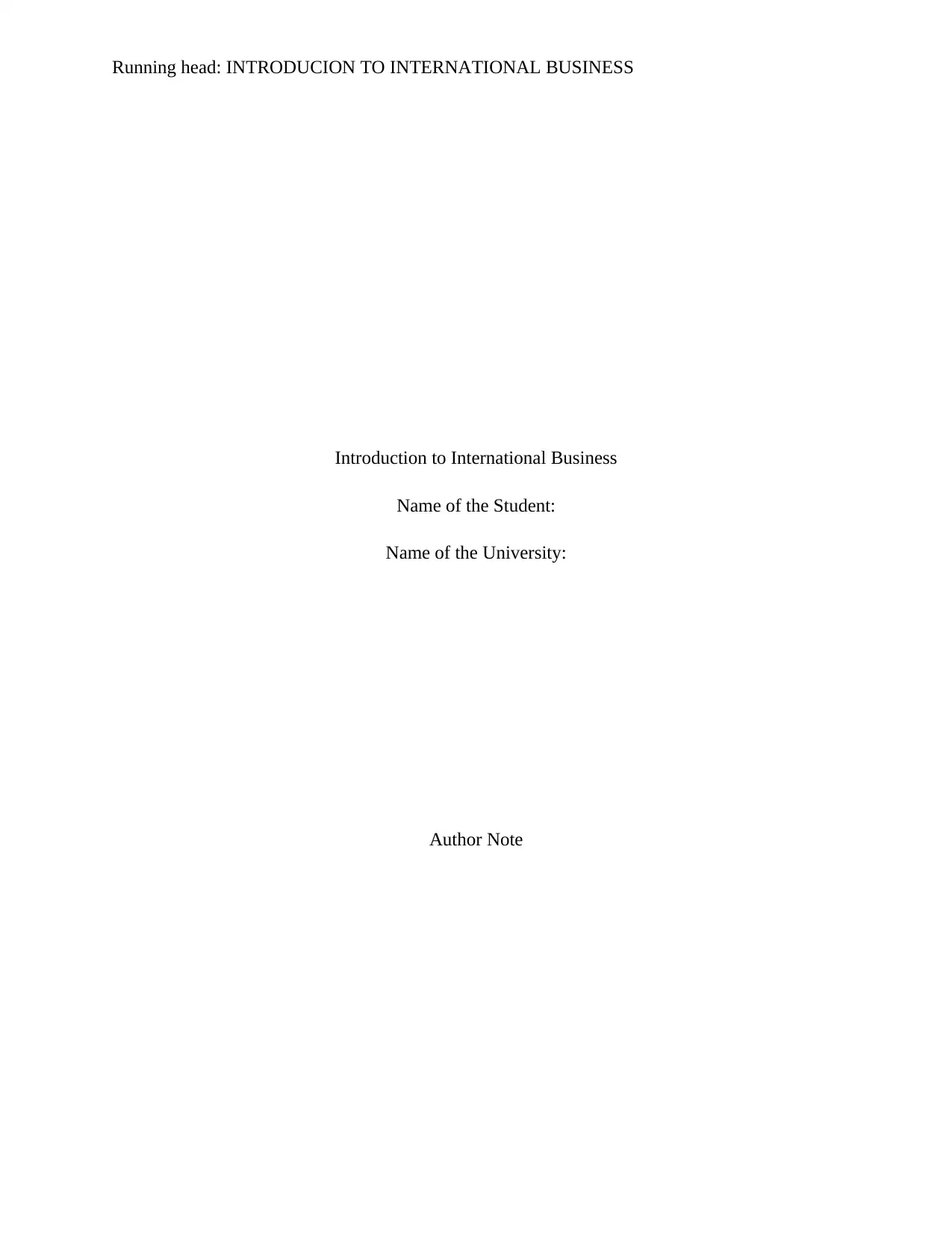
Running head: INTRODUCION TO INTERNATIONAL BUSINESS
Introduction to International Business
Name of the Student:
Name of the University:
Author Note
Introduction to International Business
Name of the Student:
Name of the University:
Author Note
Paraphrase This Document
Need a fresh take? Get an instant paraphrase of this document with our AI Paraphraser
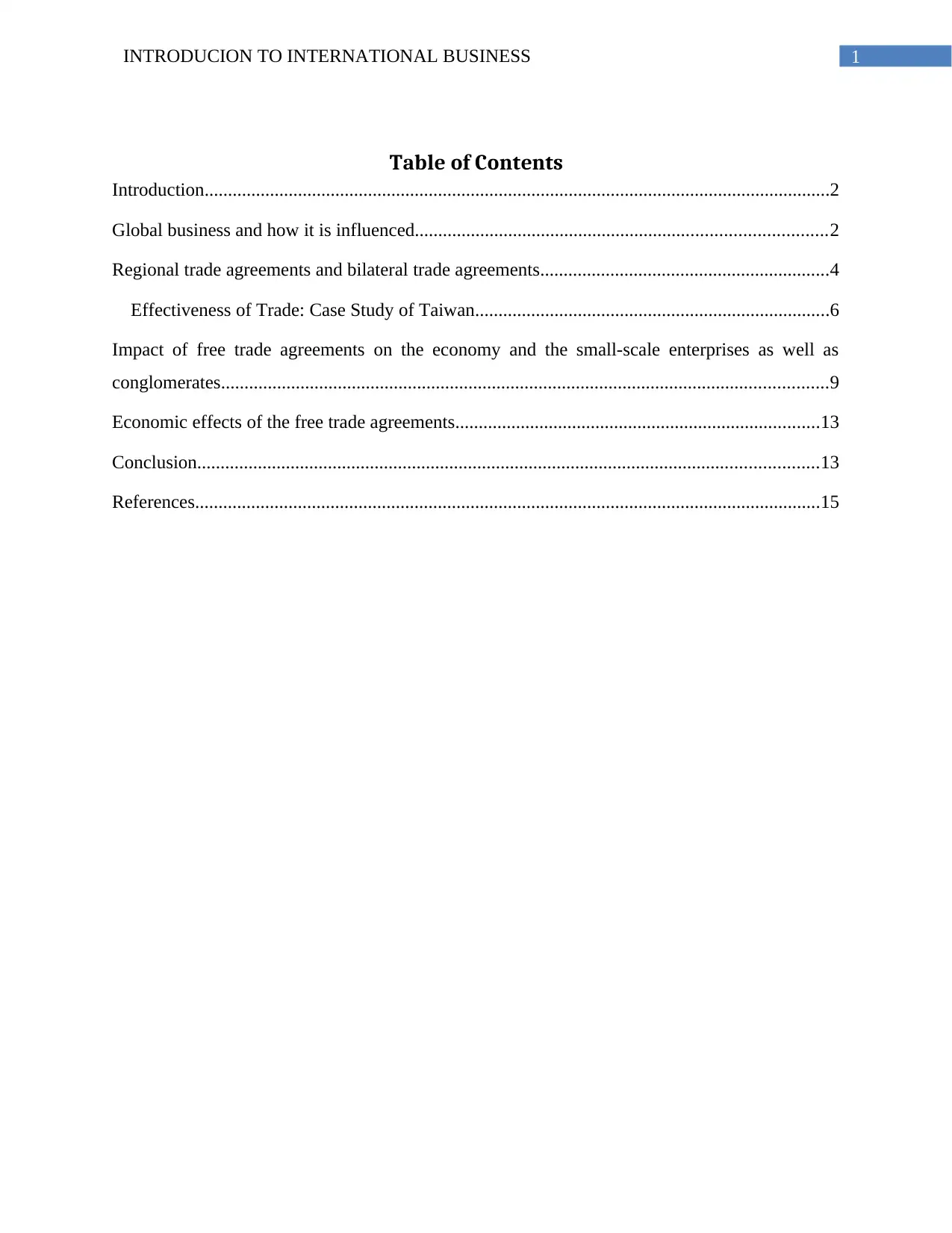
1INTRODUCION TO INTERNATIONAL BUSINESS
Table of Contents
Introduction......................................................................................................................................2
Global business and how it is influenced........................................................................................2
Regional trade agreements and bilateral trade agreements..............................................................4
Effectiveness of Trade: Case Study of Taiwan............................................................................6
Impact of free trade agreements on the economy and the small-scale enterprises as well as
conglomerates..................................................................................................................................9
Economic effects of the free trade agreements..............................................................................13
Conclusion.....................................................................................................................................13
References......................................................................................................................................15
Table of Contents
Introduction......................................................................................................................................2
Global business and how it is influenced........................................................................................2
Regional trade agreements and bilateral trade agreements..............................................................4
Effectiveness of Trade: Case Study of Taiwan............................................................................6
Impact of free trade agreements on the economy and the small-scale enterprises as well as
conglomerates..................................................................................................................................9
Economic effects of the free trade agreements..............................................................................13
Conclusion.....................................................................................................................................13
References......................................................................................................................................15
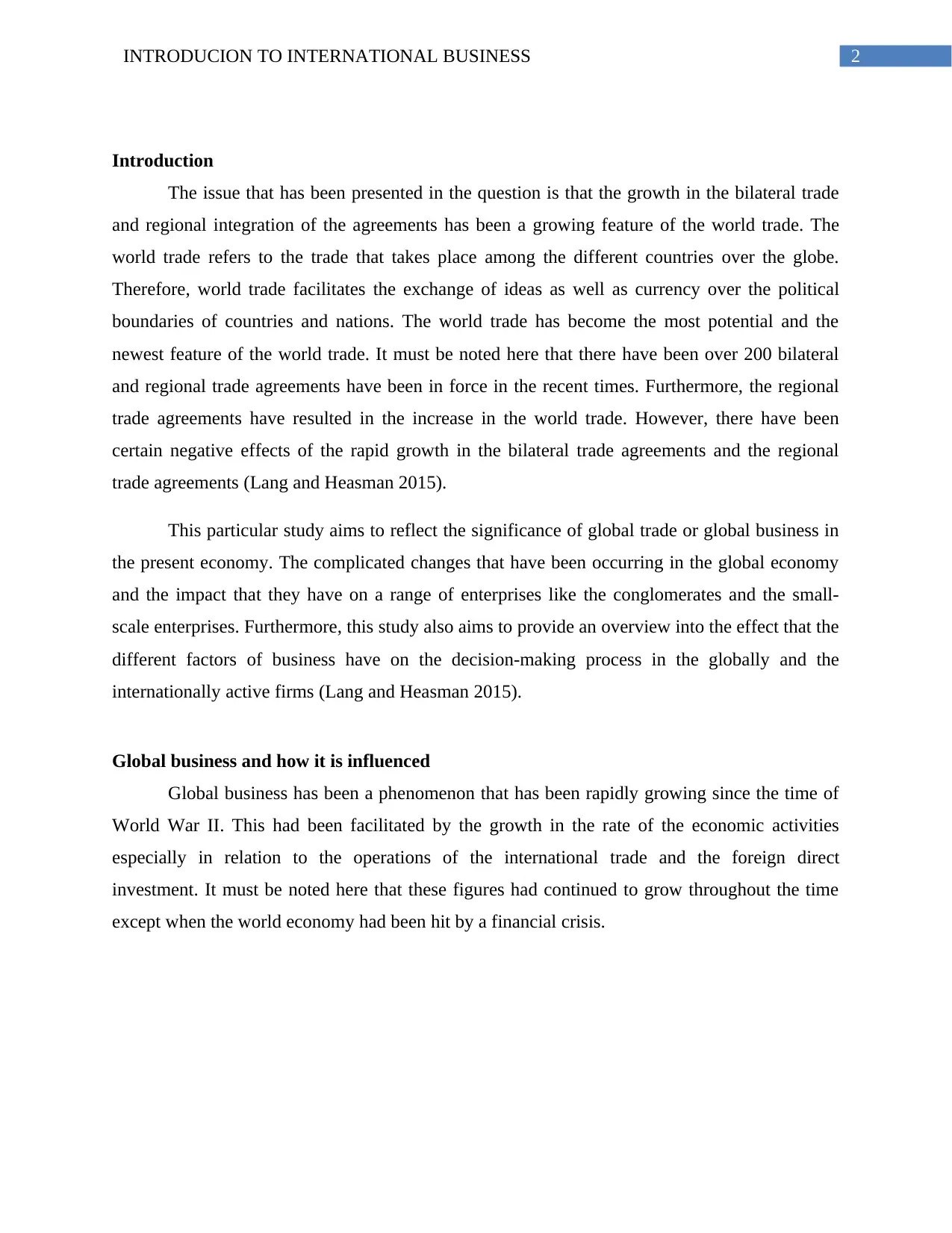
2INTRODUCION TO INTERNATIONAL BUSINESS
Introduction
The issue that has been presented in the question is that the growth in the bilateral trade
and regional integration of the agreements has been a growing feature of the world trade. The
world trade refers to the trade that takes place among the different countries over the globe.
Therefore, world trade facilitates the exchange of ideas as well as currency over the political
boundaries of countries and nations. The world trade has become the most potential and the
newest feature of the world trade. It must be noted here that there have been over 200 bilateral
and regional trade agreements have been in force in the recent times. Furthermore, the regional
trade agreements have resulted in the increase in the world trade. However, there have been
certain negative effects of the rapid growth in the bilateral trade agreements and the regional
trade agreements (Lang and Heasman 2015).
This particular study aims to reflect the significance of global trade or global business in
the present economy. The complicated changes that have been occurring in the global economy
and the impact that they have on a range of enterprises like the conglomerates and the small-
scale enterprises. Furthermore, this study also aims to provide an overview into the effect that the
different factors of business have on the decision-making process in the globally and the
internationally active firms (Lang and Heasman 2015).
Global business and how it is influenced
Global business has been a phenomenon that has been rapidly growing since the time of
World War II. This had been facilitated by the growth in the rate of the economic activities
especially in relation to the operations of the international trade and the foreign direct
investment. It must be noted here that these figures had continued to grow throughout the time
except when the world economy had been hit by a financial crisis.
Introduction
The issue that has been presented in the question is that the growth in the bilateral trade
and regional integration of the agreements has been a growing feature of the world trade. The
world trade refers to the trade that takes place among the different countries over the globe.
Therefore, world trade facilitates the exchange of ideas as well as currency over the political
boundaries of countries and nations. The world trade has become the most potential and the
newest feature of the world trade. It must be noted here that there have been over 200 bilateral
and regional trade agreements have been in force in the recent times. Furthermore, the regional
trade agreements have resulted in the increase in the world trade. However, there have been
certain negative effects of the rapid growth in the bilateral trade agreements and the regional
trade agreements (Lang and Heasman 2015).
This particular study aims to reflect the significance of global trade or global business in
the present economy. The complicated changes that have been occurring in the global economy
and the impact that they have on a range of enterprises like the conglomerates and the small-
scale enterprises. Furthermore, this study also aims to provide an overview into the effect that the
different factors of business have on the decision-making process in the globally and the
internationally active firms (Lang and Heasman 2015).
Global business and how it is influenced
Global business has been a phenomenon that has been rapidly growing since the time of
World War II. This had been facilitated by the growth in the rate of the economic activities
especially in relation to the operations of the international trade and the foreign direct
investment. It must be noted here that these figures had continued to grow throughout the time
except when the world economy had been hit by a financial crisis.
⊘ This is a preview!⊘
Do you want full access?
Subscribe today to unlock all pages.

Trusted by 1+ million students worldwide
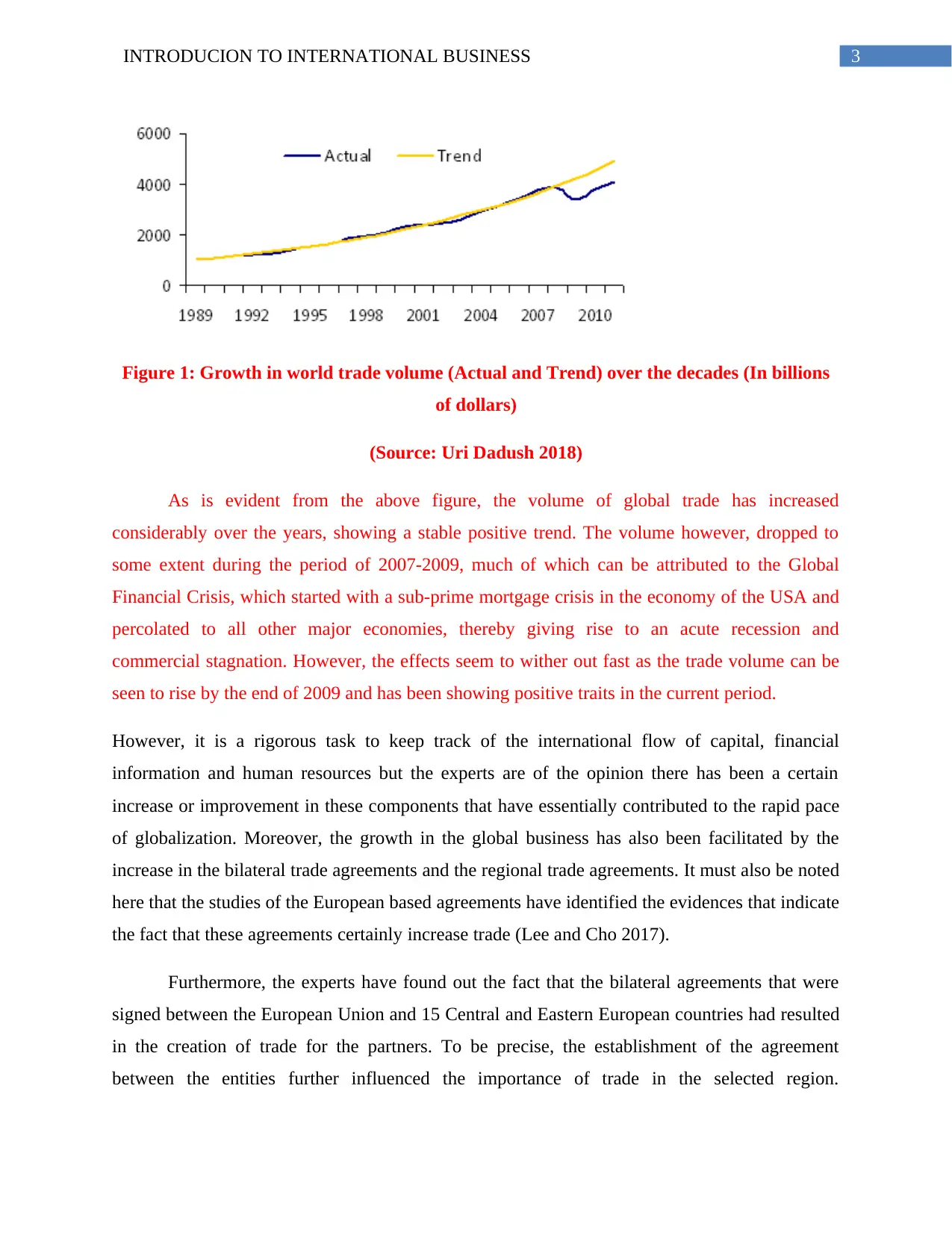
3INTRODUCION TO INTERNATIONAL BUSINESS
Figure 1: Growth in world trade volume (Actual and Trend) over the decades (In billions
of dollars)
(Source: Uri Dadush 2018)
As is evident from the above figure, the volume of global trade has increased
considerably over the years, showing a stable positive trend. The volume however, dropped to
some extent during the period of 2007-2009, much of which can be attributed to the Global
Financial Crisis, which started with a sub-prime mortgage crisis in the economy of the USA and
percolated to all other major economies, thereby giving rise to an acute recession and
commercial stagnation. However, the effects seem to wither out fast as the trade volume can be
seen to rise by the end of 2009 and has been showing positive traits in the current period.
However, it is a rigorous task to keep track of the international flow of capital, financial
information and human resources but the experts are of the opinion there has been a certain
increase or improvement in these components that have essentially contributed to the rapid pace
of globalization. Moreover, the growth in the global business has also been facilitated by the
increase in the bilateral trade agreements and the regional trade agreements. It must also be noted
here that the studies of the European based agreements have identified the evidences that indicate
the fact that these agreements certainly increase trade (Lee and Cho 2017).
Furthermore, the experts have found out the fact that the bilateral agreements that were
signed between the European Union and 15 Central and Eastern European countries had resulted
in the creation of trade for the partners. To be precise, the establishment of the agreement
between the entities further influenced the importance of trade in the selected region.
Figure 1: Growth in world trade volume (Actual and Trend) over the decades (In billions
of dollars)
(Source: Uri Dadush 2018)
As is evident from the above figure, the volume of global trade has increased
considerably over the years, showing a stable positive trend. The volume however, dropped to
some extent during the period of 2007-2009, much of which can be attributed to the Global
Financial Crisis, which started with a sub-prime mortgage crisis in the economy of the USA and
percolated to all other major economies, thereby giving rise to an acute recession and
commercial stagnation. However, the effects seem to wither out fast as the trade volume can be
seen to rise by the end of 2009 and has been showing positive traits in the current period.
However, it is a rigorous task to keep track of the international flow of capital, financial
information and human resources but the experts are of the opinion there has been a certain
increase or improvement in these components that have essentially contributed to the rapid pace
of globalization. Moreover, the growth in the global business has also been facilitated by the
increase in the bilateral trade agreements and the regional trade agreements. It must also be noted
here that the studies of the European based agreements have identified the evidences that indicate
the fact that these agreements certainly increase trade (Lee and Cho 2017).
Furthermore, the experts have found out the fact that the bilateral agreements that were
signed between the European Union and 15 Central and Eastern European countries had resulted
in the creation of trade for the partners. To be precise, the establishment of the agreement
between the entities further influenced the importance of trade in the selected region.
Paraphrase This Document
Need a fresh take? Get an instant paraphrase of this document with our AI Paraphraser
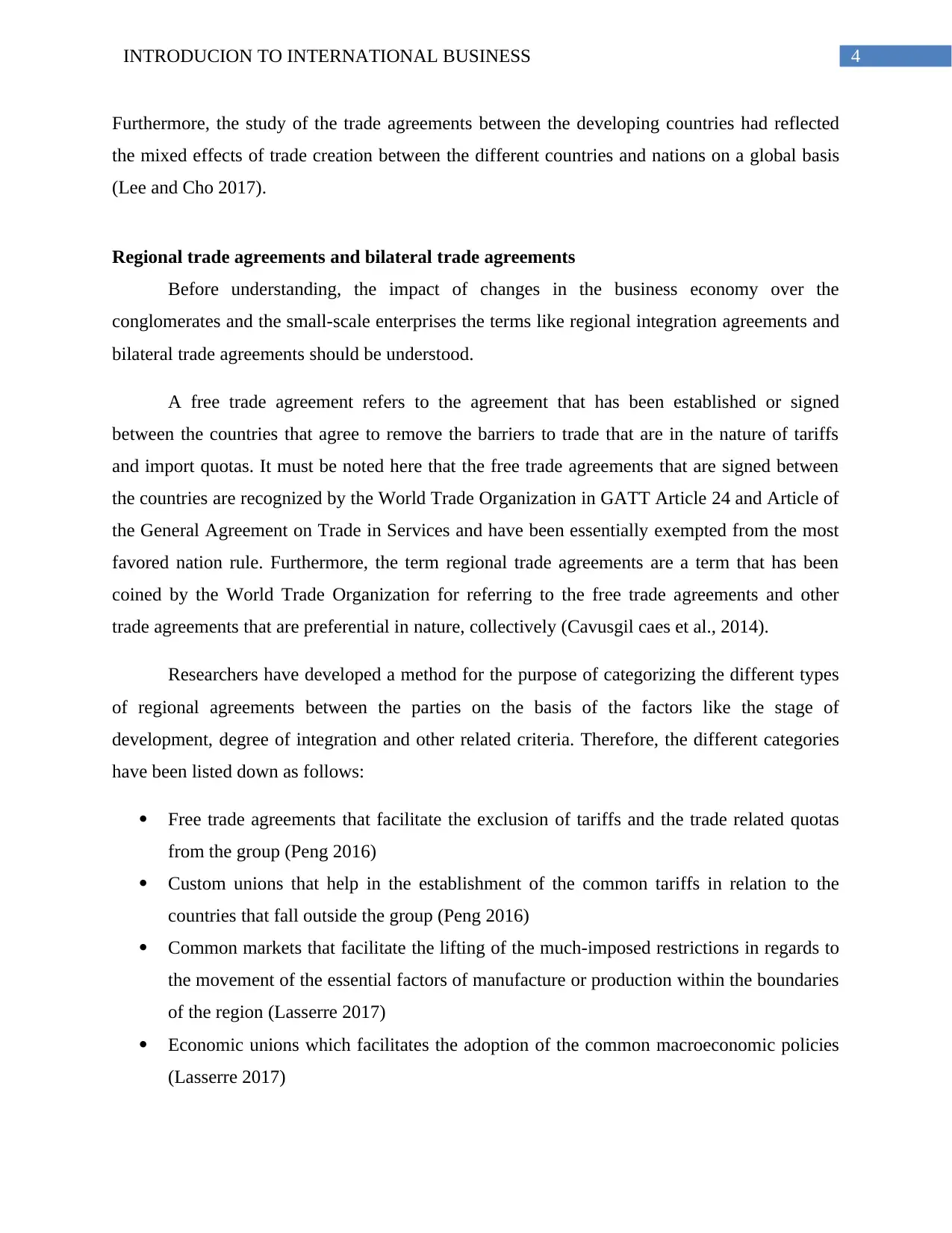
4INTRODUCION TO INTERNATIONAL BUSINESS
Furthermore, the study of the trade agreements between the developing countries had reflected
the mixed effects of trade creation between the different countries and nations on a global basis
(Lee and Cho 2017).
Regional trade agreements and bilateral trade agreements
Before understanding, the impact of changes in the business economy over the
conglomerates and the small-scale enterprises the terms like regional integration agreements and
bilateral trade agreements should be understood.
A free trade agreement refers to the agreement that has been established or signed
between the countries that agree to remove the barriers to trade that are in the nature of tariffs
and import quotas. It must be noted here that the free trade agreements that are signed between
the countries are recognized by the World Trade Organization in GATT Article 24 and Article of
the General Agreement on Trade in Services and have been essentially exempted from the most
favored nation rule. Furthermore, the term regional trade agreements are a term that has been
coined by the World Trade Organization for referring to the free trade agreements and other
trade agreements that are preferential in nature, collectively (Cavusgil caes et al., 2014).
Researchers have developed a method for the purpose of categorizing the different types
of regional agreements between the parties on the basis of the factors like the stage of
development, degree of integration and other related criteria. Therefore, the different categories
have been listed down as follows:
Free trade agreements that facilitate the exclusion of tariffs and the trade related quotas
from the group (Peng 2016)
Custom unions that help in the establishment of the common tariffs in relation to the
countries that fall outside the group (Peng 2016)
Common markets that facilitate the lifting of the much-imposed restrictions in regards to
the movement of the essential factors of manufacture or production within the boundaries
of the region (Lasserre 2017)
Economic unions which facilitates the adoption of the common macroeconomic policies
(Lasserre 2017)
Furthermore, the study of the trade agreements between the developing countries had reflected
the mixed effects of trade creation between the different countries and nations on a global basis
(Lee and Cho 2017).
Regional trade agreements and bilateral trade agreements
Before understanding, the impact of changes in the business economy over the
conglomerates and the small-scale enterprises the terms like regional integration agreements and
bilateral trade agreements should be understood.
A free trade agreement refers to the agreement that has been established or signed
between the countries that agree to remove the barriers to trade that are in the nature of tariffs
and import quotas. It must be noted here that the free trade agreements that are signed between
the countries are recognized by the World Trade Organization in GATT Article 24 and Article of
the General Agreement on Trade in Services and have been essentially exempted from the most
favored nation rule. Furthermore, the term regional trade agreements are a term that has been
coined by the World Trade Organization for referring to the free trade agreements and other
trade agreements that are preferential in nature, collectively (Cavusgil caes et al., 2014).
Researchers have developed a method for the purpose of categorizing the different types
of regional agreements between the parties on the basis of the factors like the stage of
development, degree of integration and other related criteria. Therefore, the different categories
have been listed down as follows:
Free trade agreements that facilitate the exclusion of tariffs and the trade related quotas
from the group (Peng 2016)
Custom unions that help in the establishment of the common tariffs in relation to the
countries that fall outside the group (Peng 2016)
Common markets that facilitate the lifting of the much-imposed restrictions in regards to
the movement of the essential factors of manufacture or production within the boundaries
of the region (Lasserre 2017)
Economic unions which facilitates the adoption of the common macroeconomic policies
(Lasserre 2017)
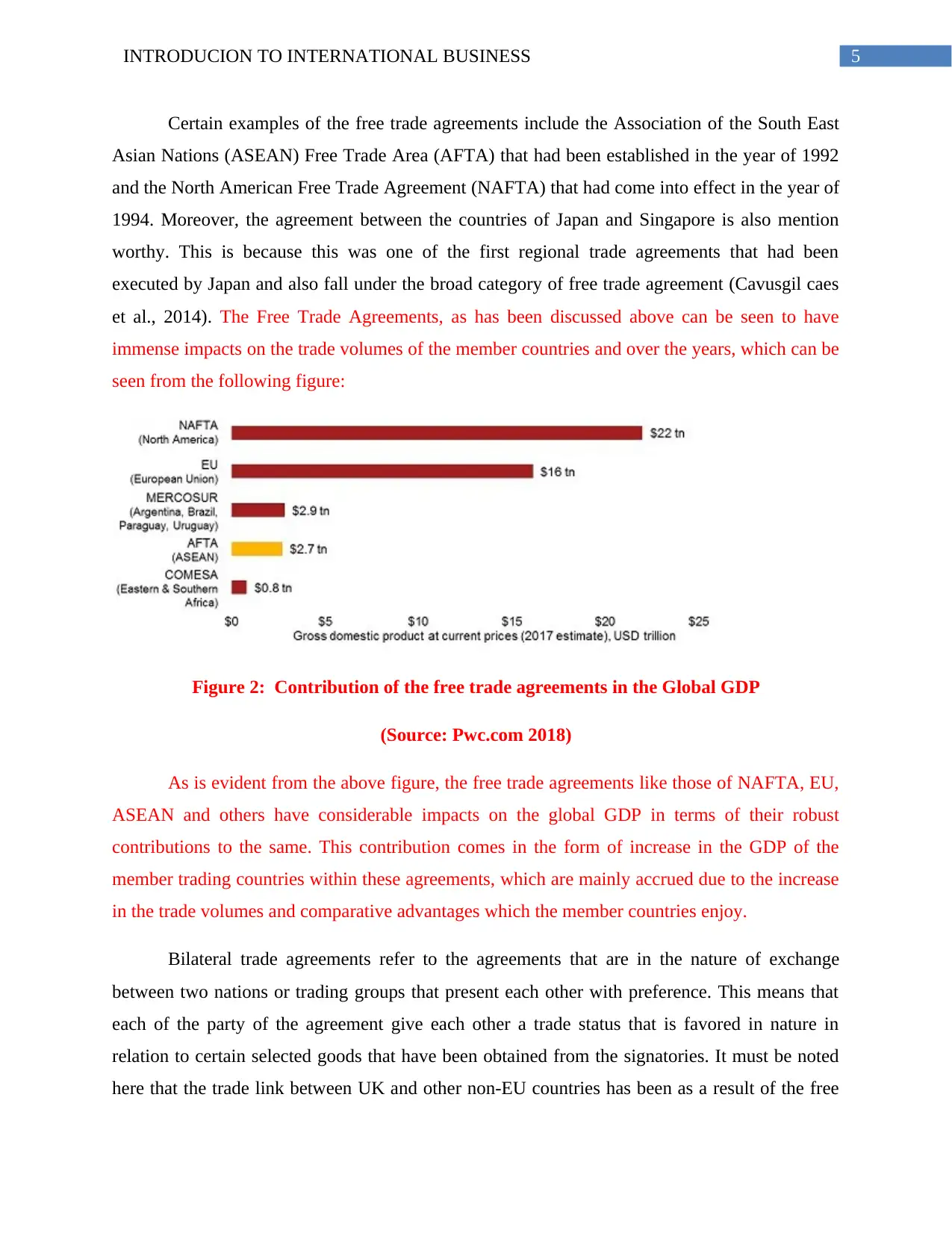
5INTRODUCION TO INTERNATIONAL BUSINESS
Certain examples of the free trade agreements include the Association of the South East
Asian Nations (ASEAN) Free Trade Area (AFTA) that had been established in the year of 1992
and the North American Free Trade Agreement (NAFTA) that had come into effect in the year of
1994. Moreover, the agreement between the countries of Japan and Singapore is also mention
worthy. This is because this was one of the first regional trade agreements that had been
executed by Japan and also fall under the broad category of free trade agreement (Cavusgil caes
et al., 2014). The Free Trade Agreements, as has been discussed above can be seen to have
immense impacts on the trade volumes of the member countries and over the years, which can be
seen from the following figure:
Figure 2: Contribution of the free trade agreements in the Global GDP
(Source: Pwc.com 2018)
As is evident from the above figure, the free trade agreements like those of NAFTA, EU,
ASEAN and others have considerable impacts on the global GDP in terms of their robust
contributions to the same. This contribution comes in the form of increase in the GDP of the
member trading countries within these agreements, which are mainly accrued due to the increase
in the trade volumes and comparative advantages which the member countries enjoy.
Bilateral trade agreements refer to the agreements that are in the nature of exchange
between two nations or trading groups that present each other with preference. This means that
each of the party of the agreement give each other a trade status that is favored in nature in
relation to certain selected goods that have been obtained from the signatories. It must be noted
here that the trade link between UK and other non-EU countries has been as a result of the free
Certain examples of the free trade agreements include the Association of the South East
Asian Nations (ASEAN) Free Trade Area (AFTA) that had been established in the year of 1992
and the North American Free Trade Agreement (NAFTA) that had come into effect in the year of
1994. Moreover, the agreement between the countries of Japan and Singapore is also mention
worthy. This is because this was one of the first regional trade agreements that had been
executed by Japan and also fall under the broad category of free trade agreement (Cavusgil caes
et al., 2014). The Free Trade Agreements, as has been discussed above can be seen to have
immense impacts on the trade volumes of the member countries and over the years, which can be
seen from the following figure:
Figure 2: Contribution of the free trade agreements in the Global GDP
(Source: Pwc.com 2018)
As is evident from the above figure, the free trade agreements like those of NAFTA, EU,
ASEAN and others have considerable impacts on the global GDP in terms of their robust
contributions to the same. This contribution comes in the form of increase in the GDP of the
member trading countries within these agreements, which are mainly accrued due to the increase
in the trade volumes and comparative advantages which the member countries enjoy.
Bilateral trade agreements refer to the agreements that are in the nature of exchange
between two nations or trading groups that present each other with preference. This means that
each of the party of the agreement give each other a trade status that is favored in nature in
relation to certain selected goods that have been obtained from the signatories. It must be noted
here that the trade link between UK and other non-EU countries has been as a result of the free
⊘ This is a preview!⊘
Do you want full access?
Subscribe today to unlock all pages.

Trusted by 1+ million students worldwide
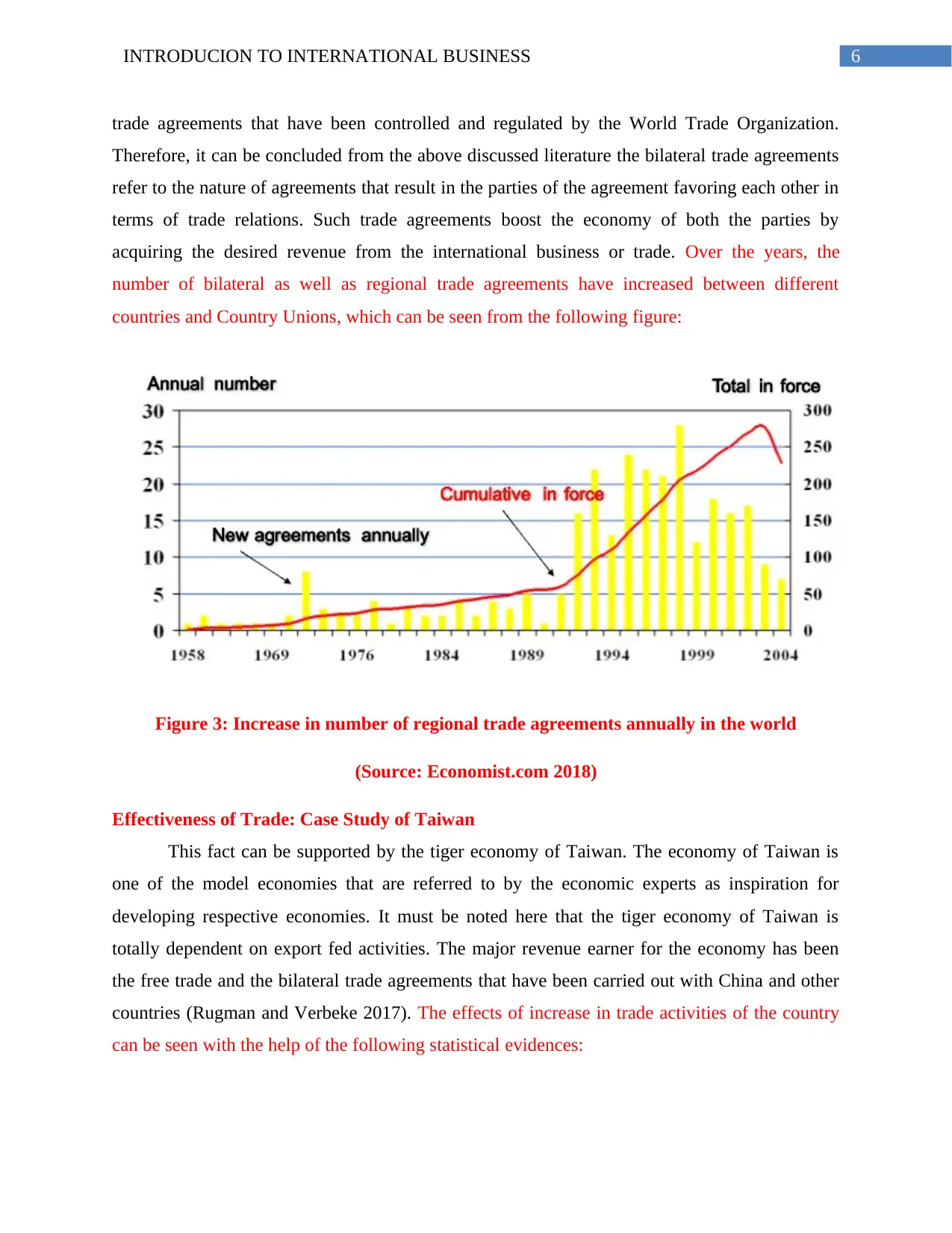
6INTRODUCION TO INTERNATIONAL BUSINESS
trade agreements that have been controlled and regulated by the World Trade Organization.
Therefore, it can be concluded from the above discussed literature the bilateral trade agreements
refer to the nature of agreements that result in the parties of the agreement favoring each other in
terms of trade relations. Such trade agreements boost the economy of both the parties by
acquiring the desired revenue from the international business or trade. Over the years, the
number of bilateral as well as regional trade agreements have increased between different
countries and Country Unions, which can be seen from the following figure:
Figure 3: Increase in number of regional trade agreements annually in the world
(Source: Economist.com 2018)
Effectiveness of Trade: Case Study of Taiwan
This fact can be supported by the tiger economy of Taiwan. The economy of Taiwan is
one of the model economies that are referred to by the economic experts as inspiration for
developing respective economies. It must be noted here that the tiger economy of Taiwan is
totally dependent on export fed activities. The major revenue earner for the economy has been
the free trade and the bilateral trade agreements that have been carried out with China and other
countries (Rugman and Verbeke 2017). The effects of increase in trade activities of the country
can be seen with the help of the following statistical evidences:
trade agreements that have been controlled and regulated by the World Trade Organization.
Therefore, it can be concluded from the above discussed literature the bilateral trade agreements
refer to the nature of agreements that result in the parties of the agreement favoring each other in
terms of trade relations. Such trade agreements boost the economy of both the parties by
acquiring the desired revenue from the international business or trade. Over the years, the
number of bilateral as well as regional trade agreements have increased between different
countries and Country Unions, which can be seen from the following figure:
Figure 3: Increase in number of regional trade agreements annually in the world
(Source: Economist.com 2018)
Effectiveness of Trade: Case Study of Taiwan
This fact can be supported by the tiger economy of Taiwan. The economy of Taiwan is
one of the model economies that are referred to by the economic experts as inspiration for
developing respective economies. It must be noted here that the tiger economy of Taiwan is
totally dependent on export fed activities. The major revenue earner for the economy has been
the free trade and the bilateral trade agreements that have been carried out with China and other
countries (Rugman and Verbeke 2017). The effects of increase in trade activities of the country
can be seen with the help of the following statistical evidences:
Paraphrase This Document
Need a fresh take? Get an instant paraphrase of this document with our AI Paraphraser
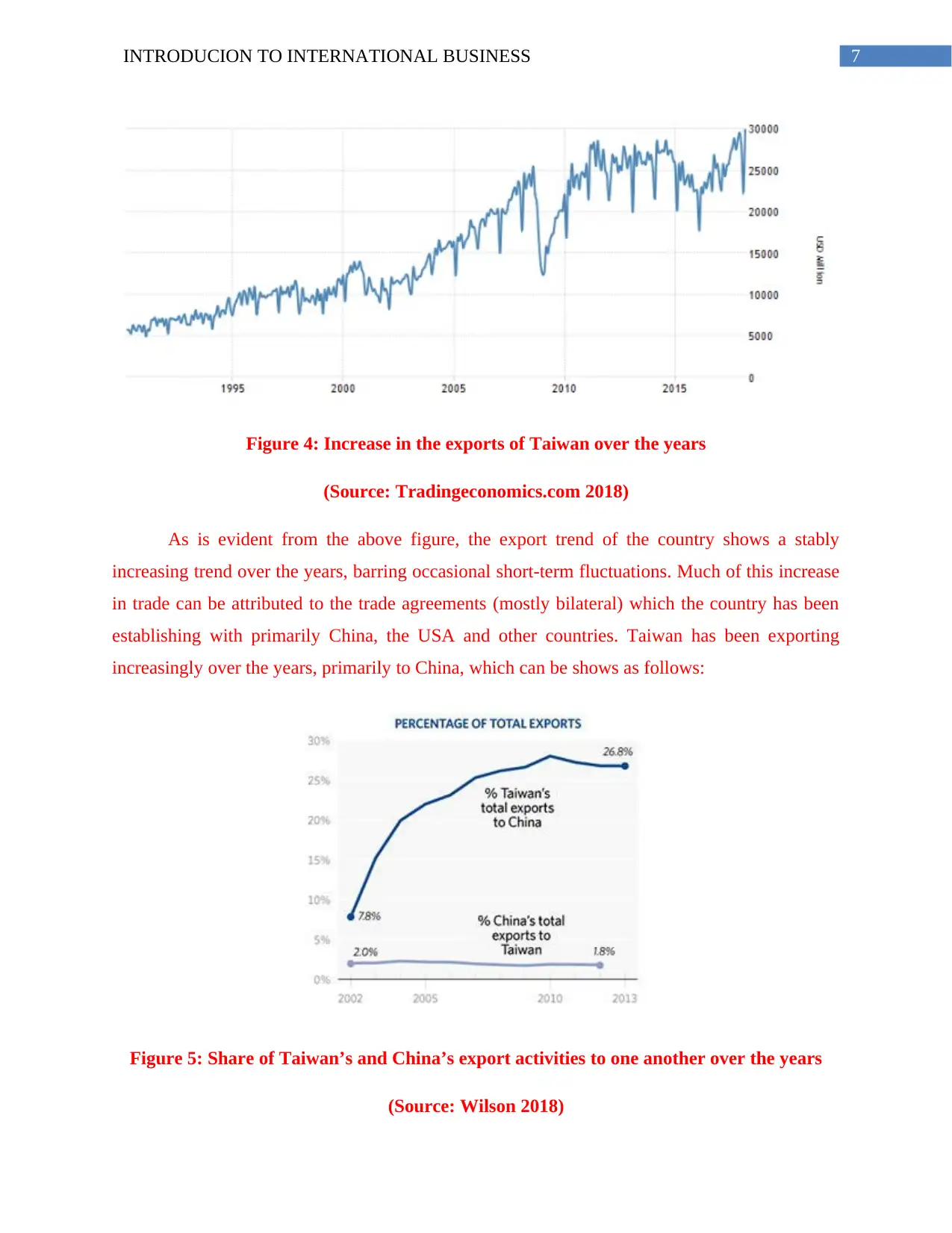
7INTRODUCION TO INTERNATIONAL BUSINESS
Figure 4: Increase in the exports of Taiwan over the years
(Source: Tradingeconomics.com 2018)
As is evident from the above figure, the export trend of the country shows a stably
increasing trend over the years, barring occasional short-term fluctuations. Much of this increase
in trade can be attributed to the trade agreements (mostly bilateral) which the country has been
establishing with primarily China, the USA and other countries. Taiwan has been exporting
increasingly over the years, primarily to China, which can be shows as follows:
Figure 5: Share of Taiwan’s and China’s export activities to one another over the years
(Source: Wilson 2018)
Figure 4: Increase in the exports of Taiwan over the years
(Source: Tradingeconomics.com 2018)
As is evident from the above figure, the export trend of the country shows a stably
increasing trend over the years, barring occasional short-term fluctuations. Much of this increase
in trade can be attributed to the trade agreements (mostly bilateral) which the country has been
establishing with primarily China, the USA and other countries. Taiwan has been exporting
increasingly over the years, primarily to China, which can be shows as follows:
Figure 5: Share of Taiwan’s and China’s export activities to one another over the years
(Source: Wilson 2018)
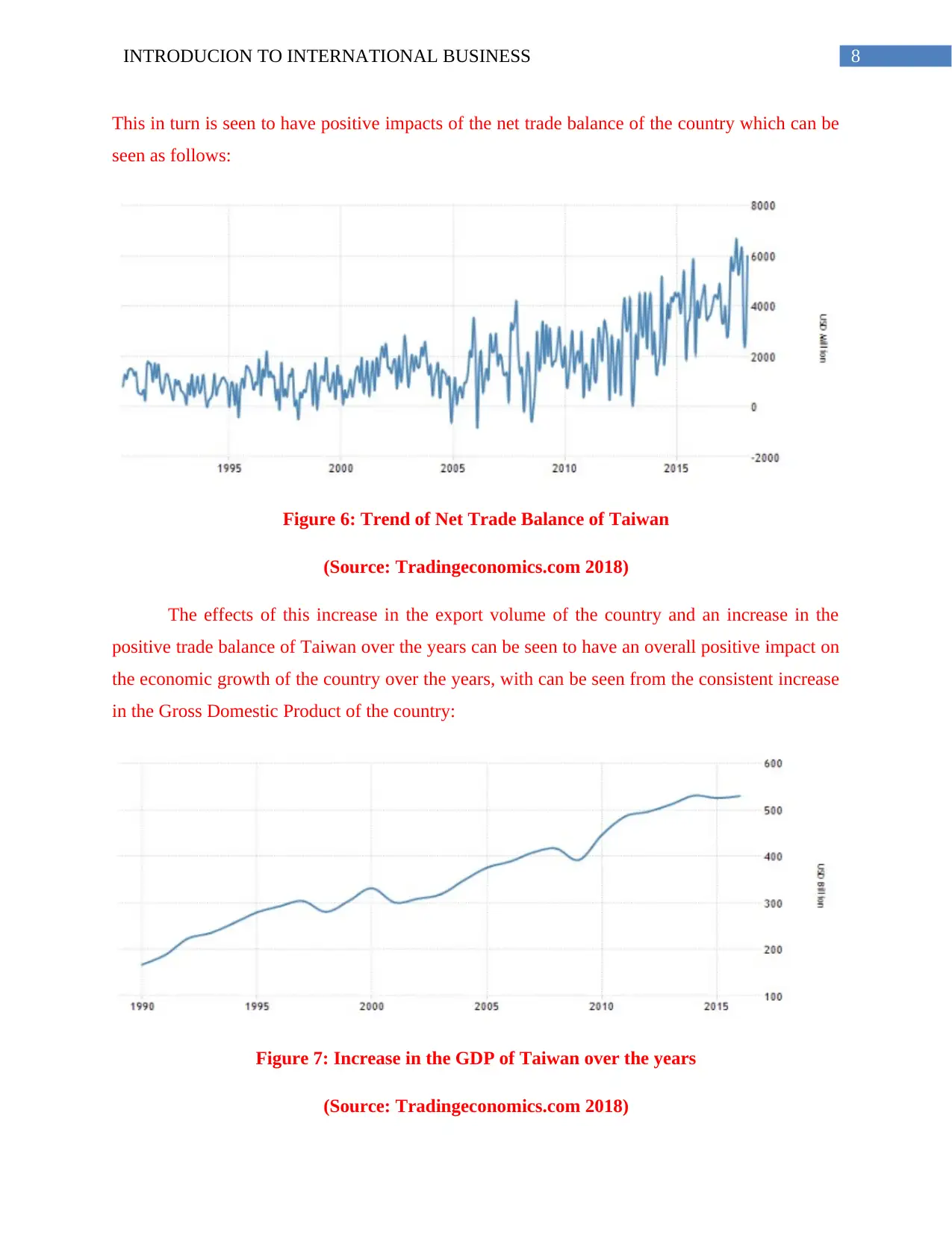
8INTRODUCION TO INTERNATIONAL BUSINESS
This in turn is seen to have positive impacts of the net trade balance of the country which can be
seen as follows:
Figure 6: Trend of Net Trade Balance of Taiwan
(Source: Tradingeconomics.com 2018)
The effects of this increase in the export volume of the country and an increase in the
positive trade balance of Taiwan over the years can be seen to have an overall positive impact on
the economic growth of the country over the years, with can be seen from the consistent increase
in the Gross Domestic Product of the country:
Figure 7: Increase in the GDP of Taiwan over the years
(Source: Tradingeconomics.com 2018)
This in turn is seen to have positive impacts of the net trade balance of the country which can be
seen as follows:
Figure 6: Trend of Net Trade Balance of Taiwan
(Source: Tradingeconomics.com 2018)
The effects of this increase in the export volume of the country and an increase in the
positive trade balance of Taiwan over the years can be seen to have an overall positive impact on
the economic growth of the country over the years, with can be seen from the consistent increase
in the Gross Domestic Product of the country:
Figure 7: Increase in the GDP of Taiwan over the years
(Source: Tradingeconomics.com 2018)
⊘ This is a preview!⊘
Do you want full access?
Subscribe today to unlock all pages.

Trusted by 1+ million students worldwide
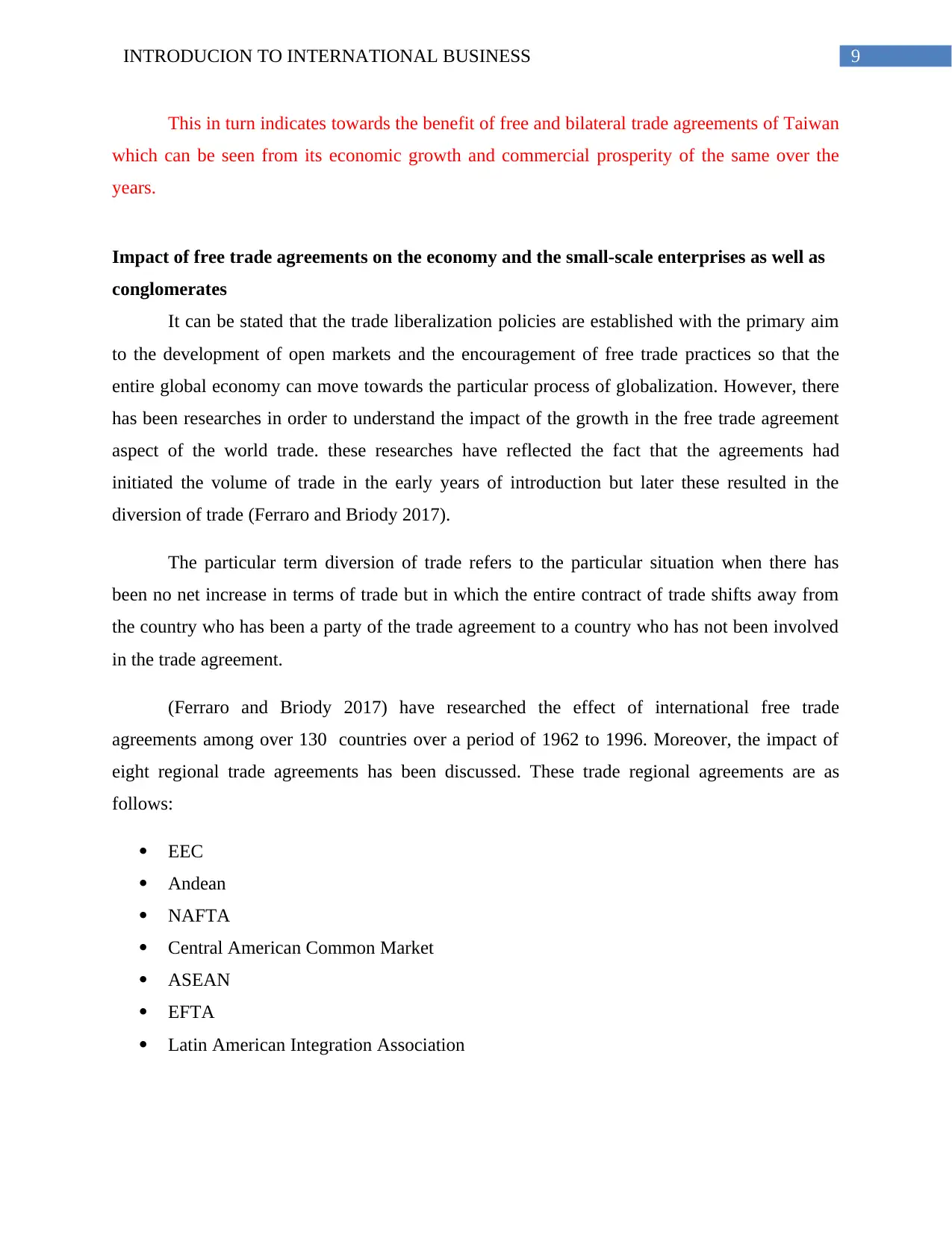
9INTRODUCION TO INTERNATIONAL BUSINESS
This in turn indicates towards the benefit of free and bilateral trade agreements of Taiwan
which can be seen from its economic growth and commercial prosperity of the same over the
years.
Impact of free trade agreements on the economy and the small-scale enterprises as well as
conglomerates
It can be stated that the trade liberalization policies are established with the primary aim
to the development of open markets and the encouragement of free trade practices so that the
entire global economy can move towards the particular process of globalization. However, there
has been researches in order to understand the impact of the growth in the free trade agreement
aspect of the world trade. these researches have reflected the fact that the agreements had
initiated the volume of trade in the early years of introduction but later these resulted in the
diversion of trade (Ferraro and Briody 2017).
The particular term diversion of trade refers to the particular situation when there has
been no net increase in terms of trade but in which the entire contract of trade shifts away from
the country who has been a party of the trade agreement to a country who has not been involved
in the trade agreement.
(Ferraro and Briody 2017) have researched the effect of international free trade
agreements among over 130 countries over a period of 1962 to 1996. Moreover, the impact of
eight regional trade agreements has been discussed. These trade regional agreements are as
follows:
EEC
Andean
NAFTA
Central American Common Market
ASEAN
EFTA
Latin American Integration Association
This in turn indicates towards the benefit of free and bilateral trade agreements of Taiwan
which can be seen from its economic growth and commercial prosperity of the same over the
years.
Impact of free trade agreements on the economy and the small-scale enterprises as well as
conglomerates
It can be stated that the trade liberalization policies are established with the primary aim
to the development of open markets and the encouragement of free trade practices so that the
entire global economy can move towards the particular process of globalization. However, there
has been researches in order to understand the impact of the growth in the free trade agreement
aspect of the world trade. these researches have reflected the fact that the agreements had
initiated the volume of trade in the early years of introduction but later these resulted in the
diversion of trade (Ferraro and Briody 2017).
The particular term diversion of trade refers to the particular situation when there has
been no net increase in terms of trade but in which the entire contract of trade shifts away from
the country who has been a party of the trade agreement to a country who has not been involved
in the trade agreement.
(Ferraro and Briody 2017) have researched the effect of international free trade
agreements among over 130 countries over a period of 1962 to 1996. Moreover, the impact of
eight regional trade agreements has been discussed. These trade regional agreements are as
follows:
EEC
Andean
NAFTA
Central American Common Market
ASEAN
EFTA
Latin American Integration Association
Paraphrase This Document
Need a fresh take? Get an instant paraphrase of this document with our AI Paraphraser
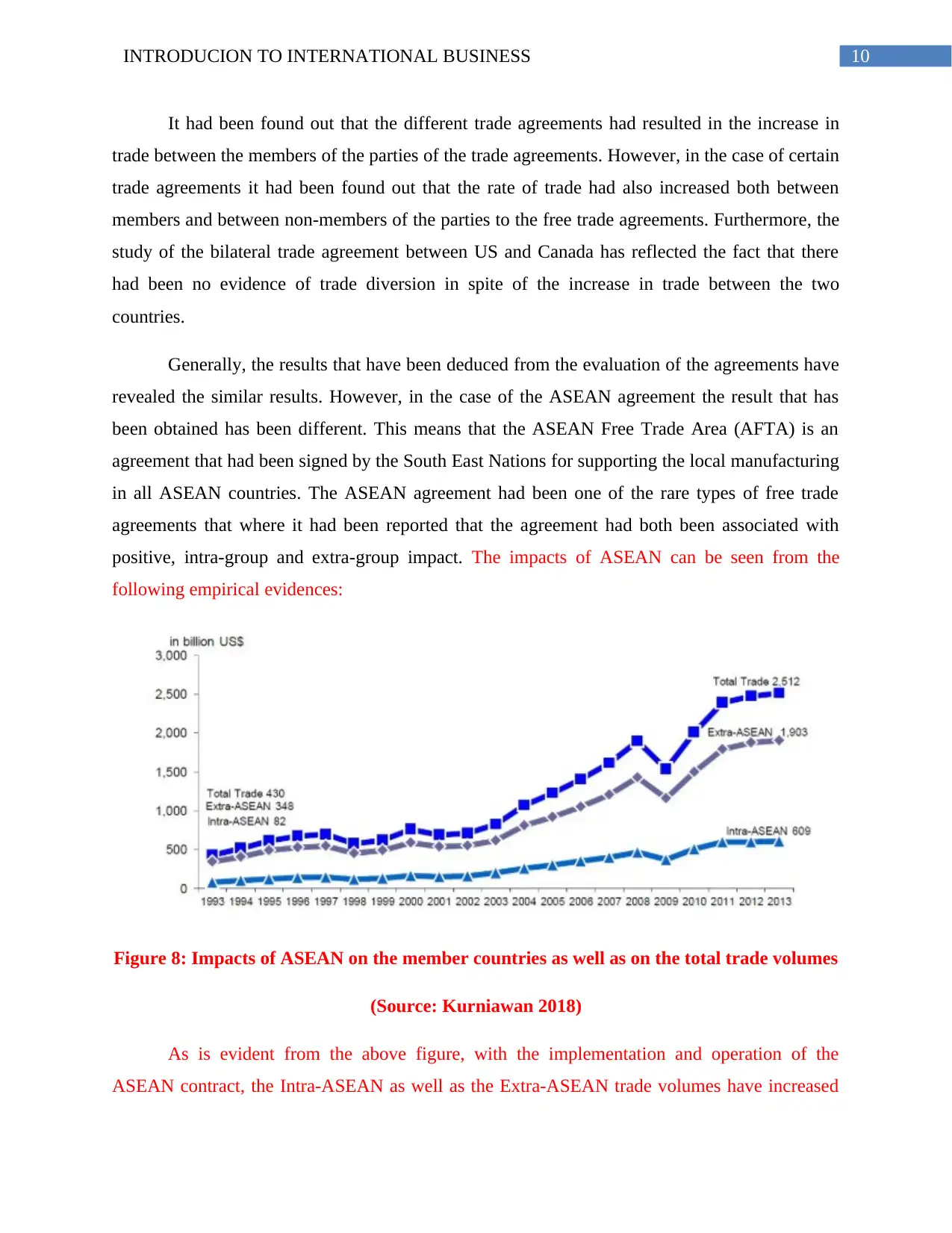
10INTRODUCION TO INTERNATIONAL BUSINESS
It had been found out that the different trade agreements had resulted in the increase in
trade between the members of the parties of the trade agreements. However, in the case of certain
trade agreements it had been found out that the rate of trade had also increased both between
members and between non-members of the parties to the free trade agreements. Furthermore, the
study of the bilateral trade agreement between US and Canada has reflected the fact that there
had been no evidence of trade diversion in spite of the increase in trade between the two
countries.
Generally, the results that have been deduced from the evaluation of the agreements have
revealed the similar results. However, in the case of the ASEAN agreement the result that has
been obtained has been different. This means that the ASEAN Free Trade Area (AFTA) is an
agreement that had been signed by the South East Nations for supporting the local manufacturing
in all ASEAN countries. The ASEAN agreement had been one of the rare types of free trade
agreements that where it had been reported that the agreement had both been associated with
positive, intra-group and extra-group impact. The impacts of ASEAN can be seen from the
following empirical evidences:
Figure 8: Impacts of ASEAN on the member countries as well as on the total trade volumes
(Source: Kurniawan 2018)
As is evident from the above figure, with the implementation and operation of the
ASEAN contract, the Intra-ASEAN as well as the Extra-ASEAN trade volumes have increased
It had been found out that the different trade agreements had resulted in the increase in
trade between the members of the parties of the trade agreements. However, in the case of certain
trade agreements it had been found out that the rate of trade had also increased both between
members and between non-members of the parties to the free trade agreements. Furthermore, the
study of the bilateral trade agreement between US and Canada has reflected the fact that there
had been no evidence of trade diversion in spite of the increase in trade between the two
countries.
Generally, the results that have been deduced from the evaluation of the agreements have
revealed the similar results. However, in the case of the ASEAN agreement the result that has
been obtained has been different. This means that the ASEAN Free Trade Area (AFTA) is an
agreement that had been signed by the South East Nations for supporting the local manufacturing
in all ASEAN countries. The ASEAN agreement had been one of the rare types of free trade
agreements that where it had been reported that the agreement had both been associated with
positive, intra-group and extra-group impact. The impacts of ASEAN can be seen from the
following empirical evidences:
Figure 8: Impacts of ASEAN on the member countries as well as on the total trade volumes
(Source: Kurniawan 2018)
As is evident from the above figure, with the implementation and operation of the
ASEAN contract, the Intra-ASEAN as well as the Extra-ASEAN trade volumes have increased
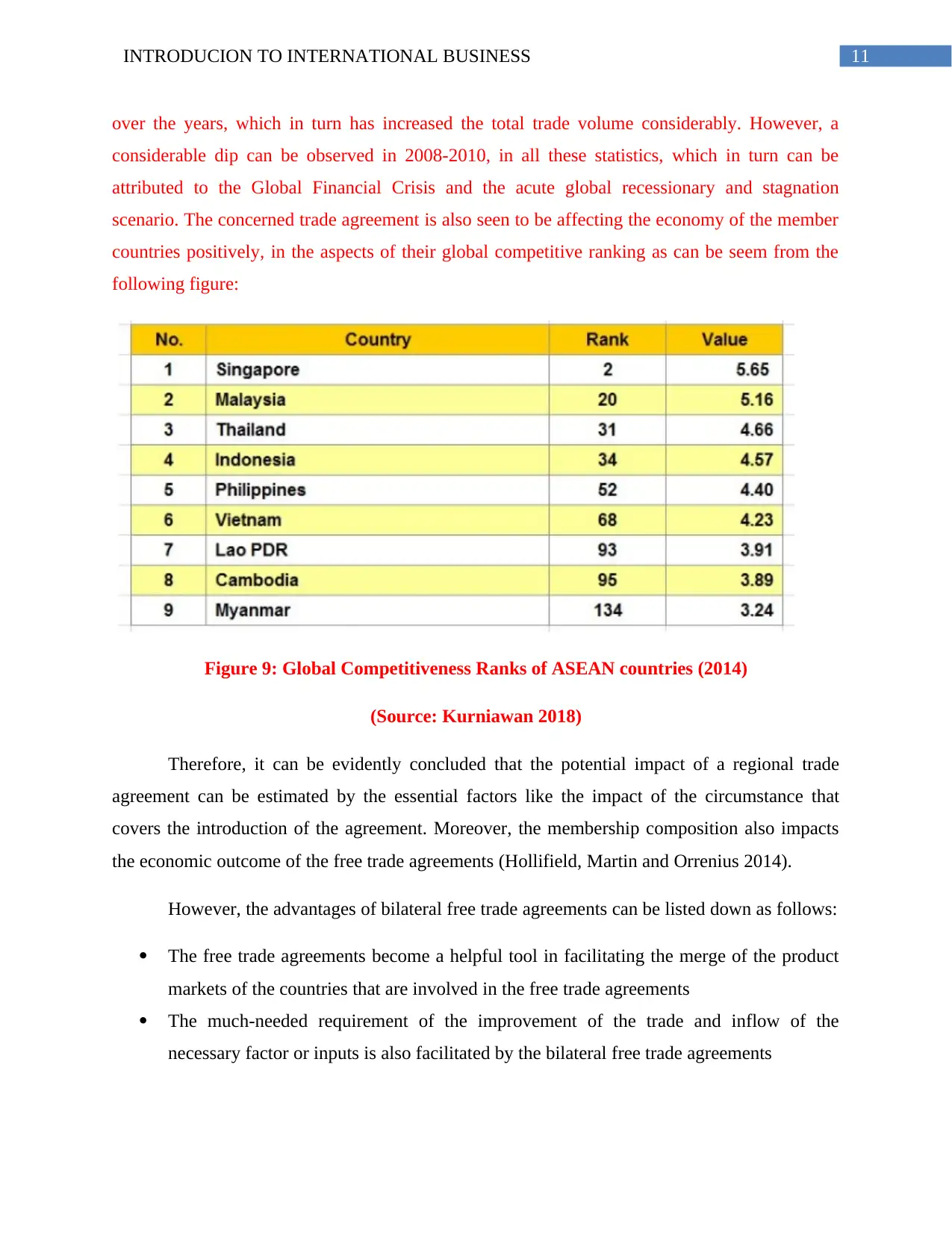
11INTRODUCION TO INTERNATIONAL BUSINESS
over the years, which in turn has increased the total trade volume considerably. However, a
considerable dip can be observed in 2008-2010, in all these statistics, which in turn can be
attributed to the Global Financial Crisis and the acute global recessionary and stagnation
scenario. The concerned trade agreement is also seen to be affecting the economy of the member
countries positively, in the aspects of their global competitive ranking as can be seem from the
following figure:
Figure 9: Global Competitiveness Ranks of ASEAN countries (2014)
(Source: Kurniawan 2018)
Therefore, it can be evidently concluded that the potential impact of a regional trade
agreement can be estimated by the essential factors like the impact of the circumstance that
covers the introduction of the agreement. Moreover, the membership composition also impacts
the economic outcome of the free trade agreements (Hollifield, Martin and Orrenius 2014).
However, the advantages of bilateral free trade agreements can be listed down as follows:
The free trade agreements become a helpful tool in facilitating the merge of the product
markets of the countries that are involved in the free trade agreements
The much-needed requirement of the improvement of the trade and inflow of the
necessary factor or inputs is also facilitated by the bilateral free trade agreements
over the years, which in turn has increased the total trade volume considerably. However, a
considerable dip can be observed in 2008-2010, in all these statistics, which in turn can be
attributed to the Global Financial Crisis and the acute global recessionary and stagnation
scenario. The concerned trade agreement is also seen to be affecting the economy of the member
countries positively, in the aspects of their global competitive ranking as can be seem from the
following figure:
Figure 9: Global Competitiveness Ranks of ASEAN countries (2014)
(Source: Kurniawan 2018)
Therefore, it can be evidently concluded that the potential impact of a regional trade
agreement can be estimated by the essential factors like the impact of the circumstance that
covers the introduction of the agreement. Moreover, the membership composition also impacts
the economic outcome of the free trade agreements (Hollifield, Martin and Orrenius 2014).
However, the advantages of bilateral free trade agreements can be listed down as follows:
The free trade agreements become a helpful tool in facilitating the merge of the product
markets of the countries that are involved in the free trade agreements
The much-needed requirement of the improvement of the trade and inflow of the
necessary factor or inputs is also facilitated by the bilateral free trade agreements
⊘ This is a preview!⊘
Do you want full access?
Subscribe today to unlock all pages.

Trusted by 1+ million students worldwide
1 out of 18
Related Documents
Your All-in-One AI-Powered Toolkit for Academic Success.
+13062052269
info@desklib.com
Available 24*7 on WhatsApp / Email
![[object Object]](/_next/static/media/star-bottom.7253800d.svg)
Unlock your academic potential
Copyright © 2020–2025 A2Z Services. All Rights Reserved. Developed and managed by ZUCOL.




